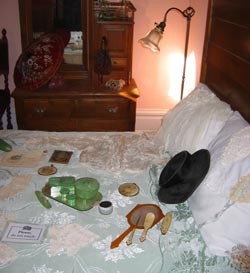
We based this on the following sources:
- In an online report, The Chicora Foundation states that the temperature should remain between 68 and 72 degrees Fahrenheit and that the humidity should stay between 40 and 50 percent. In a document titled Managing the Museum Environment the Chicora Foundation writes, “Humidity is most often associated with an increased probability of mold growth and other forms of biodeterioration. Levels at 60% RH should be considered the threshold for damage - over that level and the museum will eventually have trouble… variation in relative humidity can loosen furniture joints, cause paint to chip from canvas, and cockle paper. In addition, fluctuating relative humidity can lead to chemical reactions. Metals will corrode, many dyes will fade, and even glass and mineral collections can be damaged”
- Reports based on a conference presented by the Northeast Document Conservation Center (NEDCC) and the Museum of Fine Arts in Boston in April of 1996, show that various artifact types (such as textiles, musical instruments and historic objects) respond differently to the same climatic conditions. Therefore, temperatures near 70 degrees Fahrenheit and humidity levels near 50 percent are recommended.
- According to Stefan Michalski, Senior Conservation Scientist at the Canadian Conservation Institute, institutions with mixed historical collections should “strive for conditions that average plus or minus 20 percent relative humidity…even a single event of plus or minus 40 percent relative humidity can produce small to severe risk to collections and must be avoided at all costs”.
- Data from the WAAC Newsletter supports a standard of 70 degrees Fahrenheit with a relative humidity level of 50 percent. According to Conservation Analytical Laboratory researchers, “there can be as much as plus or minus 15 percent fluctuation in relative humidity and as much as 10C (50 F) difference in temperature.”
- According to James Reilly, Director of Image Permanence Institute in Rochester, environmental damage due to temperature and relative humidity conditions include:
- Mechanical Damage: warping, shrinking, swelling, cracking that is caused by humidity that is either too high, too low or with changes occurring too fast
- Biodeterioration: mold or insects, caused by interaction of temperature and relative humidity
- Inherent Chemical Decay or Natural Aging: the material reacts with itself at a rate determined by temperature and relative humidity
Source:
Mille O’Connell for the Abbey Newsletter
Volume 20, Number 4-5 September 1996 http://palimpsest.stanford.edu/byorg/abbey/an/an20/an20-4/an20-411.html
Chicora Foundation, Inc.
PO Box 8664
861 Arbutus Drive
Columbia, South Carolina 29202-8664
http://palimpsest.stanford.edu/byorg/chicora/chicenv.html
WAAC Newsletter
Volume 17, Number 1, Jan 1995, p.23
http://palimpsest.stanford.edu/waac/wn/wn17/wn17-1/wn17-109.html